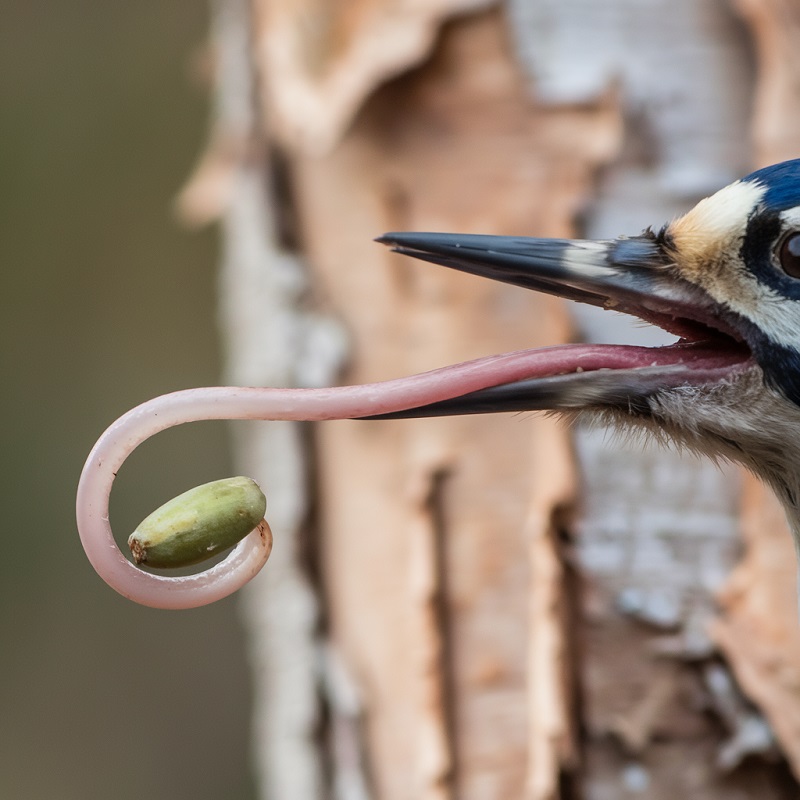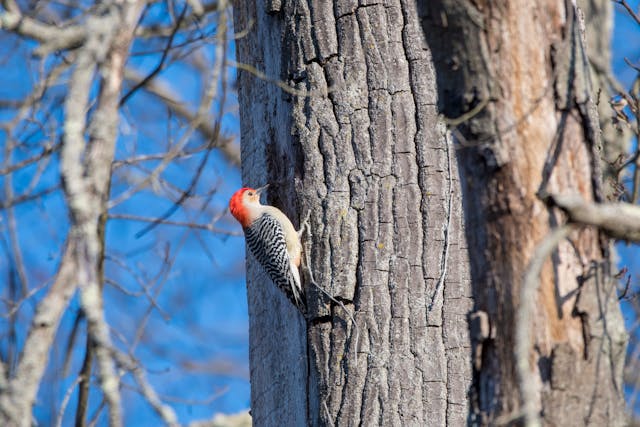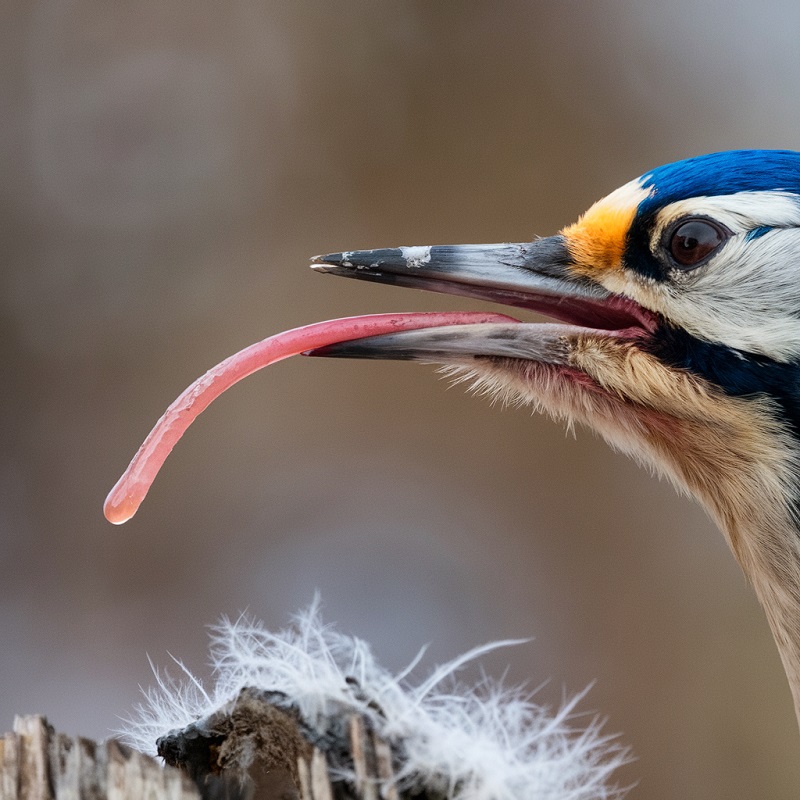The woodpecker tongue is one of natures most clever designs, for a bird that spends a lot of time drilling into tree bark. But there’s more to it than just catching bugs! From its length to its protective features, a woodpeckers tongue is a key part of their survival. Let’s take a look at what makes this tiny tool so cool and why it’s perfect for its owner’s unusual lifestyle.
What Makes the Woodpeckers Tongue So Awesome?
When we think about animals with unusual tongues, creatures like frogs or anteaters might come to mind, but the woodpecker tongue holds its own as a natural wonder. While most bird tongues have specific functions for eating or drinking, the woodpecker’s tongue does much more—it’s designed to act as a shield and tool, providing a unique form of protection!

How Long is a Woodpecker’s Tongue?
One of the first amazing facts is just how long a woodpecker’s tongue is. In some species, it can be nearly twice the length of its beak, extending up to 4 inches in larger woodpeckers like the Pileated Woodpecker. This length is essential for reaching deep into tree bark and pulling out insects, larvae, and other goodies hidden within.
| Woodpecker Species | Average Tongue Length |
| Downy Woodpecker | 2.5 inches |
| Pileated Woodpecker | 4 inches |
| Northern Flicker | 3.5 inches |
Where Does the Tongue Go When It’s Not in Use?
Unlike our tongues, the woodpecker’s isn’t just a muscle that sits in the mouth—it’s actually anchored inside the bird’s skull. When not in use, the tongue curls around the back of the head, even wrapping around the eye sockets in some species! This unique storage solution provides a protective buffer for the brain when the bird is hammering into wood, acting almost like a built-in helmet.

Do Woodpeckers Wrap Their Tongues Around Their Brain?
Yes, one of the most fascinating adaptations in woodpeckers is that they do wrap their tongues around their brains—in a way. When a woodpecker’s tongue isn’t extended, it retracts back and curves up behind the skull, looping around the back of the head, and in some species, it even wraps around the eye sockets. This unique arrangement creates a protective cushion that absorbs shocks and minimizes the impact on the brain each time the woodpecker drills into a tree. It’s like a natural shock absorber, so the brain doesn’t get damaged from all that rapid, forceful pecking. Woodpeckers can peck up to 20 times a second without damaging their brain, no other bird can do that.
The Woodpecker Tongue as a Shock Absorber
Each time a woodpecker pecks at a tree, it experiences powerful impact forces. Amazingly, the woodpecker’s tongue works as a shock absorber. By coiling around the skull, the tongue helps distribute the impact and reduces the pressure on the brain, allowing woodpeckers to avoid injury while they work.
Fun Fact: How Many Times Does a Woodpecker Peck?
Some woodpeckers can peck 20 times per second! That means they can make up to 12,000 pecks a day, all without damaging their skull or brain.
What Do Woodpeckers Use Their Tongues For?
A woodpecker’s tongue is primarily a tool for finding food. Since they’re mainly insectivores, their tongues help them dig into crevices and holes to reach bugs. Some woodpeckers even use their tongues to lap up sap or nectar. The long reach of the tongue is essential for extracting insects from deep tree bark crevices, while the sticky saliva and barbs on the tip make it perfect for catching and holding slippery insects. Some woodpeckers are attracted to tree sap, which they can lap up with a brush-like tip on their tongue.
- Extracting insects: The tongue’s long reach helps pull insects out of deep tree bark crevices.
- Lapping up sap: Some woodpeckers are attracted to tree sap, which they can lap up with a brush-like tip on their tongue.
- Grabbing grubs: With sticky saliva and barbs on the tip, the tongue is perfect for catching and holding slippery insects.
The Sticky and Barbed Tongue Tip
The tip of the woodpecker’s tongue is covered in tiny barbs, and the tongue is coated with sticky saliva. This helps the woodpecker snare its prey so that bugs don’t escape once they’re caught. It’s almost like nature designed a tiny fishing hook and bait for the woodpecker!
Different Species, Different Tongues
There are more than 200 species of woodpeckers worldwide, and their tongues vary slightly based on their environment and diet. For example:
- Northern Flickers have slightly shorter tongues, as they spend more time on the ground looking for ants.
- Pileated Woodpeckers have stronger, longer tongues since they often dig into larger, thicker trees.
List: Examples of Woodpecker Tongue Types
- Sap-licking Tongues: Some species have brushy tips suited to collect sap.
- Insect-hunting Tongues: Barbed and sticky, perfect for capturing insects.
- Ground-foraging Tongues: Slightly shorter, helpful for digging on the forest floor.
Woodpecker Adaptations
According to data from ornithological studies, woodpeckers’ tongue lengths and skull structures are evolving slightly in response to their habitats and food sources. In areas with fewer trees, for example, certain species develop shorter, stronger beaks and tongues as they adapt to different food sources on the ground. It’s a fascinating look at how woodpeckers are able to adapt and thrive in diverse environments.
| Species | Adaptation Type | Function |
| Red-bellied Woodpecker | Long, sticky tongue | Digging in bark for insects |
| Northern Flicker | Shorter, flexible tongue | Foraging on the ground for ants |
| Acorn Woodpecker | Sharp, pointed tongue | Collecting acorns and small bugs |
How Does a Woodpecker Tongue Compare to Other Birds?
Birds’ tongues are as varied as their diets, but the woodpecker tongue stands out for its combination of length, mobility, and structure. Most birds have fairly short, flat tongues, but the woodpecker’s is like a precision tool. This makes it a close competitor with other unique bird tongues, such as:
- Hummingbirds, with their straw-like tongues for nectar
- Owls, whose shorter tongues are suited to swallowing whole prey
- Parrots, with highly mobile tongues that can manipulate seeds
FAQs About Woodpecker Tongues
- Why do woodpeckers have such long tongues?
- The woodpecker’s tongue length allows it to reach deep into tree bark to find insects, even in hard-to-reach crevices.
- How do woodpeckers protect their brains when pecking?
- Their tongues coil around the skull, acting as a shock absorber and protecting the brain from impact.
- Can woodpeckers hurt themselves from so much pecking?
- Thanks to specialized skull structures and the cushioning from their tongues, woodpeckers avoid injury even when pecking thousands of times a day.
- Do all woodpeckers eat insects?
- Most woodpeckers eat insects, but some species, like the Yellow-bellied Sapsucker, also consume sap and nectar.
Conclusion
The woodpeckers tongue is an amazing example of natures adaptability, designed to protect, hunt and help these birds survive. Whether they’re hunting insects, lapping sap or drilling holes the woodpeckers tongue is the right tool for the job. This little bird’s hidden superpower not only makes them special but also shows how evolution meets the demands of survival.
From their long tongues to their shock absorbing skulls, woodpeckers show us that it’s the little things that count. Next time you hear a woodpecker pecking away, think about the tiny superpower working for them every day!




